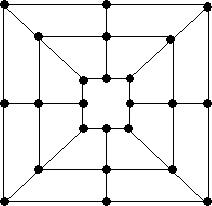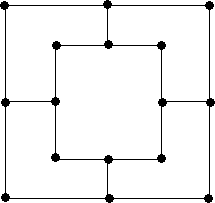
- The Siege group
- Home
- Who we are
- Living History
- On the Camp
- Costume
- 2007 Events
- News
- Membership info
- Picture Gallery
- Contact us
- Links
- Yahoo Group
- Site Credits
- The 17th Century
- Music
- Cookery
- Handicrafts
- Children
- Games
- Weaponry
- The Civil War
Games
Many of the games which were played in the seventeenth century have survived in some form until the present day.
We've collected some of them here so that you (or your children) can act out a piece of the history. Some of them have a full page of rules, which you might prefer to print out and practice later, thereby keeping them alive for future generations.
Excerpts are taken from the manuscript of the scholar Francis Willughby, with additional information obtained from various other sources.
Tossing the Horseshoe
This game is still played at village fetes to this day. A metal post marks the throwing point and another one, about 2 metres away, is the target to toss the horse-shoe onto. Each player has three goes, scoring a point every time a horseshoe hooks around the metal post.
Play can take place from each end alternately and the player with the most points after an agreed number of games is the winner.
Barley Break
| o | ||
| A | E | |
| B | CD | F |
| n |
Barley Break is played mainly by 3 sets of mixed couples. Couples AB and EF would be at either end of the playing area, whilst couple CD would be in a place named "Hell" right in the middle between both couples (as shown in the diagram above).
All 3 couples will hold hands and couple AB would start the game off by shouting out "Barley". Couple EF would then respond by shouting back "Break".
Both couples AB and EF would then run to meet each other (A to meet up with E and B to meet up with F). It is couple CD's job to catch either couple before they meet the person they are trying to get to, otherwise the turn will not count.
If couple CD succeeds in catching either couple AB or EF then it will be that couple's turn to go into the middle of the playing area and couple CD take the captured couple's place in the playing area. However if couple CD don't succeed, they must stay in the middle until they do succeed.
Posts can be placed in positions o and n. This is to make it more difficult for the couples to meet up as they must go around the posts to cross the middle, enabling couple CD to catch them easily. Another tactic that can be used is to send only one person from each side across to the other side, resulting in the middle pair trying to catch them before they reach their opposite end.
More than 6 people can play the game this way as the ones who ran to the opposite side can go to the end of the line at the far side.
Bowls
To play bowls you need two hardwood balls for each player, approximately the same size as an apple. Each team's balls should be colour coded. You will also need a "Mistress" (an upright stake in the ground) or alternatively a "Jack" (a smaller ball in a totally different colour e.g. white).
To play bowls a casting point is set on one end of the playing area (called the pitch). The mistress is set up at the opposite end to the casting point (to save walking back and forth, set up 2 mistresses one near the casting site and the other at the opposite end of the casting site).
If you would rather not use a mistress then you can use a jack, which should be cast down to the opposite end of the pitch.
The players then take it in turns to get their balls as close to the mistress or jack as possible using only the 2 balls. Balls can be knocked away from the jack or mistress by other balls.
The ball closet to the jack at the end of the game scores 1 point, if both balls of the same player are closet to the jack then he scores 2 points.The first player to win an agreed number of games (usually 5 or 7) is the winner.
Quoits is similar to bowls except that you use quoits (large flat stones or pieces of metal) instead of bowls. The mistress is a iron stake or "hob" driven into the ground (or a stone or metal jack can be used).
Nine Pins
To play nine pins you will need nine Bone or Hardwood Pins (one of these pins will be the "ten" pin and should be taller than the others). A Hardwood Ball (apple sized) is also required.
To mark the casting off point a small piece of metal (trig) or something similar is set into the ground.
The pins are set-up into a square shape consisting of three rows (called the ruck), the ruck can be found some distance away from the casting off point.
The players take it in turns to knock down as many of the pins as possible with the ball. The more pins they hit the more points they will earn. Each pin is worth one point, but the ten pin is worth ten points when it is knocked over by itself or two points when it is knocked over with the other pins.
After the player has cast his first ball he can go to the spot where the ball has stopped and try to pick up the ten pin or he can cast the ball a second time. All the points of both casts are added together.
The pins will then be set-up again for the next player to have his turn. The first player to reach 31 will win, but any player who scores over 31 gets his score dropped back down to 16 and is allowed another cast.
A different way to play nine pins is to have a smaller pin called a "Margery" or "Madge". This pin will be placed in the middle between the trig and the ruck, and is worth five points when it is knocked down.
Another rule that can be adhered to is that the second cast can only be taken if the first cast hits one of the pins in the ruck. This will prevent a player from using the first cast to set-up an ideal second cast if their score is near to 31.
Rope and Boxes
You take two boxes, both of which must be a similar size (about 3 handspans square and one or two spans in height).
The boxes are placed firmly upon the ground and each contestant must then stand upon a box.
Each contestant then takes hold of one end of a large piece of rope (twice as thick as your thumb, and a full rod or two in length). When the order is given to pull, each contestant must pull on the rope and try to pull the other player off his box or cause them to lose their grip on the rope.
Instead of using a rope you can use pillow cases filled with rags to hit each other with until one of the contestants falls off their box.
Fivestones
A simple game of catch, using five stones. Toss one in the air, but pick up the others singly before catching it. Next, pick them up in pairs before catching and so on. Good for hand-eye co-ordination.
Read a discussion of the game and the complete rules
Hopscotch
An outdoor game played on a hard surface. You will need chalk to mark out the grid (or a suitable flagstoned area) and a stone or tile for a counter, to toss into progressive cells of the grid.
Several writers talk of hopscotch designs being scratched into the pavement of ancient Rome's forum. Also there is the common notion that Hopscotch was converted from an ancient 'labyrinth' game, by early Christians, into a representation of the journey to heaven. Hence the familiar cross-shaped patterns representing the Basilica of the early Christian church.
Hopscotch summarises the game extremely well when one discovers that scotch is an old word for score or incision.The player hops over the scotches, moving the counter ahead of them. The game is described in a little poem in John Newberry's A Little Pretty Pocket Book (1774):
Hopscotch
First make with chalk an oblong square,
with wide partitions here and there;
Then to the firlt [first?] a tile convey;
Hop in - then kick the tile away.
Rule of Life
Strive with good senfe to stock your mind,
And to that senfe be virtue join'd.
- Malachi Scales
Sources:
Children's Games with Things, Opie & Opie
(1998).
Dictionary of British Folklore, A.B. Gomme (1896).
Children's Games, L. Diaken (1946)
Merrill's
Merrill's is an old game and a version, noughts and crosses.
Three Men's Morris, or Smaller Merrill's, can be traced to Ancient Egypt around 1400 BC. The board would consist of 9 holes or marks in 3 lines of 3, each person would have 3 playing pieces. Each player would take turns placing pieces on the board, trying to get 3 pieces in a row.
If no single row was made during the placing phase of the game, the game is allowed to continue by moving pieces alternatively from one square in any direction until one player obtains a single line of 3 pieces in a row. This player is then said to be the winner.
This game was popular in Medieval Europe and nine-hole playing surfaces have been recorded in benches at Westminster Abbey and in the Cathedrals at Canterbury, Norwich and Chichester.
A more complex version of the game is called Nine Men's Morris, or Greater Merrill's. Boards can be seen in many medieval illustrations and one was found, scratched into a table, on the Mary Rose (Henry VIII's Flagship).
Two designs of board are shown below and they can be made from a piece of wood approximately 8" square with the pattern scoured with a hot iron. Other alternatives for boards are scouring them into a trestle table, scratching a pattern in the ground or a board sewn or marked onto an off cut of fabric.
 |
 |
| Nine Men's board A | Nine Men's board B |
 |
 |
| Six Men's board | Three Men's board |
The rules are similar to the simpler game. However, each player has nine pieces and takes turns laying them down, one by one, on spots on the board, the aim being to get three in a row.
When a player gets three in a row (called milling) they are allowed to remove one of the other player's pieces (called pounding). The pounded piece cannot be part of a mill unless there is no other option.
When all the pieces have been placed, they are moved one spot at a time, players taking turns, in any direction in the attempt to make a mill. The winner is the person to pound all the other person's pieces.
Normally the diagonals do not count for mills, although if players agree they can be moved along. Some players allow the same mill to be unmade and remade indefinitely, others do not, and this should be decided before play.
Another interesting variation is; when the first player gets to three pieces only, instead of having to move to an adjacent point, they can move to any empty point. This variation is useful if the skill levels of the players are different and redresses the balance somewhat.
Six Men's Morris can be played and this has a different, simpler, board design. However, an interesting (although un referenced!) variation is to have three players play on a Nine Men's board, each with six pieces.
Sources:
Pleasures and Pastimes in Medieval England; P
Reeves (1996)
Children's Games with Things, Opie & Opie (1998)
Dictionary of British Folklore, A.B. Gomme (1896)
Children's Games. L. Diaken (1946)
The Merry Gamester. 3rd Ed, Nelson W (1996)
English Sports and Past Times. Hole C (1949)
Games for Two, John Wasley (1991)
The 'Games' pages are dedicated to the memory of Darren Lambert, who researched the material for these pages.